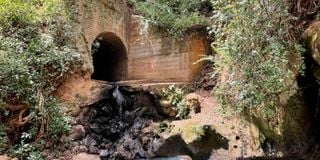Forest trails and train tracks

The ‘Dark Tunnel’ in the Kijabe Hills.
The popularity of hiking clubs has soared in Kenya in recent years – a trend influenced by the global wave of health and fitness consciousness triggered by the Covid pandemic. There are now far more websites and blogs with detailed accounts of scenic hiking excursions across the country, and particularly of the many hills, valleys and forests within reach of Nairobi.
Among them are the Kijabe Hills: a row of densely forested ridges of the Great Rift Valley’s Kikuyu Escarpment. This was the latest site chosen for the monthly hike of a group from VMX Fitness – the large gym on the third floor of Village Market’s modern shopping wing. As a member of the gym, I was encouraged by staff to join them on the hike, which I did on the first weekend of August.
It took us just over an hour to reach Gichiengo on the Nairobi-Nakuru Highway, where we turned left onto the Kijabe Road and continued to the National Oil petrol station behind the Rift Valley Academy football pitch. This was the starting point of our hike, and where we met our guides for the day, Nehemia Njuguna and Evans Thuku, who are rangers of the Kijabe Forest Trust (KFT).
KFT has worked hard since 2013 to protect a narrow stretch of forest on the escarpment known as the Kijabe Forest Strip. This was once part of a contiguous forest belt that ran from the eastern shoulder of the Rift Valley to the Aberdares in the northeast and then south to Nairobi. However, the area has since been fragmented by decades of encroachment, resource pressure and land use change, and the Kijabe Forest Strip is now the last isolated patch of dry upland forest on the escarpment.
With their partners, the KFT team are implementing a range of initiatives to conserve the forest. Nehemia, Evans and the other rangers conduct daily patrols and log the wildlife and illegal activities that they encounter. They have also helped to restore hundreds of thousands of trees and to develop non-timber forest product enterprises for the surrounding communities (including the collection of the juniper berries used in the production of the award-winning Procera gin). Eco-tourism is a growing source of revenue, too, such as guiding big hiking groups like ours from VMX.
Forested slopes
Nehemia led us first through a stunning stretch of primary indigenous forest and then along the outskirts of Kijabe Town. From here we began our climb up the imposing, green-cloaked ridges of the escarpment, eventually emerging onto the tracks of the Uganda railway line. We traced the railway south, gazing up at the forested slopes on one side and down towards the Rift Valley floor on the other.
We turned off the railway into the forest again and clambered down into a valley with a cave and a hot spring. Here, we stood beneath the tangled roots of a tall strangler fig and splashed our faces with the warm water trickling down the side of the valley. We continued upstream to the ominously-named ‘Dark Tunnel’ – a one-kilometre-long embankment tunnel beneath the railway. We ventured as far into the water-eroded tunnel as we could (and dared) and ducked as a colony of bats zipped past our heads.
We had been on the trail for two hours by this point but the most challenging section of the hike was still to come. We trekked back up the embankment, crossed the railway line and navigated a steep ridge up the escarpment. It was worth the effort for the panoramic views at the summit, especially of Kenton Hill and Mount Longonot to the west.
By the time we emerged at our pick-up point at Soko Mjinga on the Nairobi-Nakuru Highway, we had been on our feet for five hours. It was a tough but very rewarding hike and a fantastic way to help KFT conserve a vital patch of indigenous forest.
For more information, head to www.kijabeforest.org. To join future VMX hikes, keep an eye on www.vmx-fitness.com for updates.
Email: [email protected]





